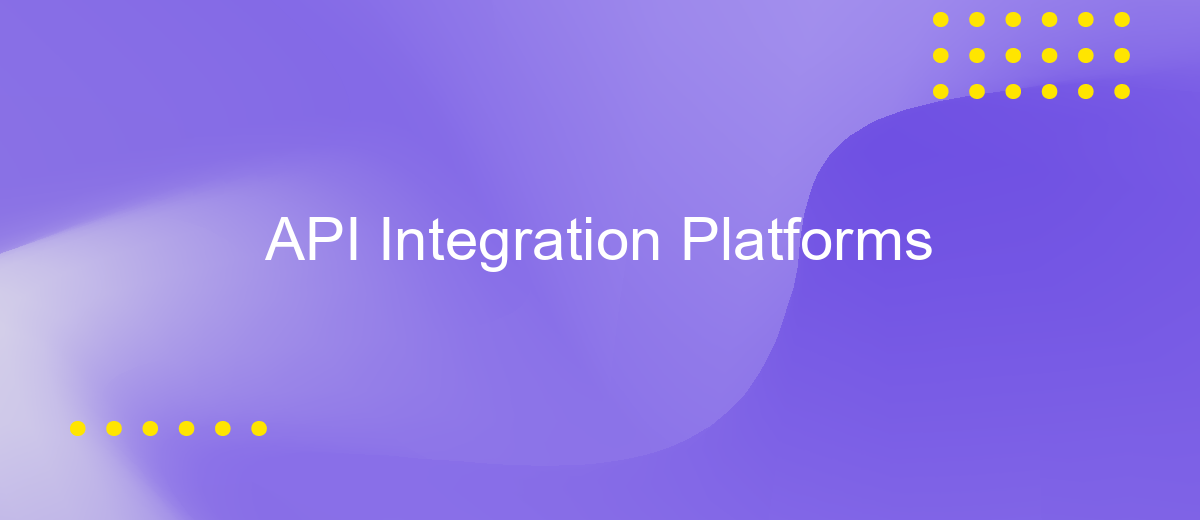API Integration Platforms
In today's fast-paced digital landscape, API integration platforms have become essential tools for businesses seeking seamless connectivity and enhanced functionality. These platforms enable organizations to efficiently connect disparate systems, automate workflows, and unlock new opportunities for innovation. By leveraging API integration, companies can streamline operations, reduce costs, and improve customer experiences, making it a crucial component of modern business strategies.
Understanding API Integration Platforms
API integration platforms have become essential tools for businesses looking to streamline their operations and enhance connectivity between various software applications. These platforms serve as intermediaries that facilitate the seamless exchange of data and functionalities across different systems. By doing so, they help organizations automate processes, reduce manual intervention, and improve overall efficiency.
- Centralized management of API connections
- Support for a wide range of APIs and protocols
- Scalability to handle growing data volumes
- Robust security features to protect data integrity
- User-friendly interfaces for easier configuration and monitoring
Choosing the right API integration platform involves considering factors such as compatibility with existing systems, ease of use, and the level of support provided. With the right platform, businesses can unlock new opportunities for innovation and growth by enabling more dynamic and responsive interactions between their various digital assets. This ultimately leads to better decision-making and improved customer experiences.
Key Features and Benefits

API Integration Platforms are designed to simplify and streamline the process of connecting disparate systems and applications. One of the key features is their ability to automate workflows, reducing the need for manual intervention and minimizing errors. These platforms often provide a user-friendly interface that allows even non-technical users to set up integrations effortlessly. For instance, ApiX-Drive offers a straightforward, no-code solution that enables businesses to connect various apps and services quickly, enhancing operational efficiency.
Another significant benefit of API Integration Platforms is their scalability. As businesses grow, these platforms can easily adapt to increased data volumes and more complex workflows. They also offer robust security features to protect sensitive data during transfers. Additionally, platforms like ApiX-Drive provide real-time data synchronization, ensuring that all connected systems are always up-to-date. This not only improves decision-making processes but also boosts overall productivity by enabling seamless communication across different software solutions.
Types of API Integration Platforms

API integration platforms have become essential tools for modern businesses, enabling seamless connectivity between disparate systems and applications. These platforms facilitate the automation of workflows, enhance collaboration, and improve data exchange. Understanding the different types of API integration platforms can help organizations choose the right solution to meet their specific needs.
- iPaaS (Integration Platform as a Service): Cloud-based solutions that offer scalable and flexible integration capabilities, allowing businesses to connect various applications and data sources without extensive coding.
- ESB (Enterprise Service Bus): Middleware solutions that facilitate communication between different applications within an enterprise, ensuring reliable message delivery and orchestration.
- API Management Platforms: Tools that focus on creating, securing, and managing APIs, providing businesses with analytics and monitoring capabilities to optimize API performance.
Each type of API integration platform offers unique features and benefits. iPaaS solutions are ideal for organizations seeking agility and scalability, while ESBs are suited for complex, enterprise-level integrations. API management platforms are essential for businesses prioritizing API governance and security. Selecting the appropriate platform depends on factors such as integration complexity, scalability requirements, and budget considerations.
Choosing the Right Platform

When selecting an API integration platform, it's crucial to consider your organization's specific needs and objectives. The right platform should align with your current infrastructure and future growth plans. Begin by assessing the complexity of your integration requirements and the types of APIs you will be working with.
Next, evaluate the platform's ease of use and learning curve. A user-friendly interface and robust documentation can significantly reduce the time required to implement and maintain integrations. Additionally, consider the level of customer support and community engagement the platform offers, as these can be invaluable resources.
- Compatibility with existing systems and tools
- Scalability to accommodate future growth
- Security features to protect sensitive data
- Cost-effectiveness and pricing model
Finally, conduct a thorough comparison of potential platforms by testing their features and capabilities through demos or trials. This hands-on experience will provide insight into how well each platform meets your integration needs, ultimately guiding you to make an informed decision that supports your organization's long-term success.


Best Practices and Future Trends
When integrating APIs, adhering to best practices ensures seamless connectivity and enhanced performance. Prioritize security by implementing robust authentication methods such as OAuth 2.0 and regularly updating API keys. Optimize data handling by minimizing payload sizes and using efficient data formats like JSON. Additionally, thorough documentation and version control are crucial for maintaining clarity and consistency across integrations. Platforms like ApiX-Drive offer user-friendly interfaces and automation tools that simplify the setup and management of API integrations, making it easier to follow these best practices.
Looking ahead, the future of API integration platforms is poised for significant advancements. The rise of AI and machine learning will lead to smarter, more predictive integrations, enabling systems to adapt dynamically to changing conditions. Additionally, the increasing adoption of low-code and no-code platforms will democratize API integration, allowing non-developers to create complex workflows effortlessly. As businesses continue to demand more agility and efficiency, platforms like ApiX-Drive will evolve, offering even more sophisticated tools to meet the growing needs of digital ecosystems.
FAQ
What is an API integration platform?
How does an API integration platform work?
What are the benefits of using an API integration platform?
How can I ensure security when using an API integration platform?
Can I integrate multiple applications using an API integration platform without technical expertise?
Time is the most valuable resource for business today. Almost half of it is wasted on routine tasks. Your employees are constantly forced to perform monotonous tasks that are difficult to classify as important and specialized. You can leave everything as it is by hiring additional employees, or you can automate most of the business processes using the ApiX-Drive online connector to get rid of unnecessary time and money expenses once and for all. The choice is yours!

